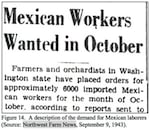
The Japanese attack on Pearl Harbor during World War II caught all of America off guard, and the rapid transition to a country at war transformed just about every aspect of the American economy.
The agricultural industry faced an especially confounding dilemma. On the one hand, World War II created a skyrocketing demand for agricultural products. On the other hand, the war caused vast numbers of agricultural workers to abandon the fields, either to join the military or to seek more lucrative work in the cities.
In Oregon, farmers explored an array of creative solutions to this dire agricultural labor shortage. Few sources of local planters and pickers went untapped. In short, everyone from housewives to students, German POWs to tavern customers to bank employees were called on to help. But here, as elsewhere across the country, local solutions were simply not enough.
The eventual answer was an international agreement between the United States and Mexico, an arrangement for American farms and railroads to contract with temporary Mexican workers. Officially named the Emergency Farm Labor Supply Program, it ultimately came to be known as the Bracero program.
In Oregon, the Bracero program ran from 1943-1947. By the time the program ended in Oregon, over 200,000 men had been supplied to the United States from Mexico as farm labor. About 15,000 of those men helped harvest Oregon crops.
The braceros saved American agriculture during the war years. Yet to this day, those hundreds of thousands of men are given little recognition.
Broadcast Date: May 7, 2007






